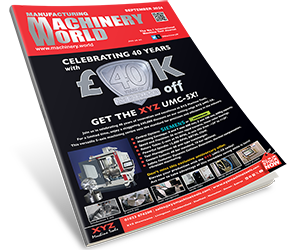As a company that specialises in providing innovative electro-mechanical solutions to the aerospace and defence sectors, NEMA Ltd is at the cutting edge of technology. Specialists in transforming concepts into an achievable reality, Rochdale-based NEMA work with virtually all of the UK’s leading aerospace OEMs as well as being integral in collaborative research projects. To work at this end of the industry, the company invests in machine tools from the Engineering Technology Group (ETG).
Founded in 1954, AS: 9100 certified NEMA has a rich tradition of being at the forefront of technology, working with the aerospace, defence, marine and high voltage switchgear sectors since its inception. The company acquired its first ETG turning centres back in 2018 and this has been followed by 3D printing technology, a Mitsubishi EDM and most recently a Quaser MV184 CNC machining centre with a Nikken 4th axis rotary system.
As a company that holds customer approvals from household names like BAE Systems, GE Aviation, Martin Baker, Westland, Collins Aerospace and Airbus UK to name a few, NEMA is intent on retaining its high-quality levels and exceeding customer expectations – this is why it works with ETG.
Commenting upon the relationship with Wellesbourne-based ETG, NEMA Managing Director Mr Andy Wilding says: “We have worked with ETG for several years and they always have the solution we require. The staff are friendly, supportive, and always available and we have a great relationship – but most importantly, the technology is fantastic. We have bought machines across virtually every technology discipline from ETG and all our workholding and toolholding requirements are also fulfilled by ETG Group company Hyfore Workholding. They supply all our collets, vices, lathe chucks and even the VDI tooling for our turning centres.”
Alluding to why the 40-employee business required a new machining centre, Andy continues: “We have a machining centre that is now approaching 20 years old and whilst it still performs brilliantly, we want to reduce our reliance on an older machine that is susceptible to increased maintenance and downtime than a newer machine – especially as we win more new work. Additionally, a lot of our milling work revolves around the design, development and manufacture of electric motors for the next generation of ‘electrified’ aircraft. As the motor units evolve to generate more power, they subsequently increase in size and our 400 by 800mm bed on the existing machining centre was too small for many of the new parts coming through our door. As well as a swelling order book that demands more machining capacity, these are two key reasons why we bought the 3-axis Quaser MV184 VMC with a Nikken fourth-axis rotary unit.”
The Quaser MV184 provides 1200 by 600mm bed with a working range of 1020 by 610 by 610 in the X, Y and Z axes. This easily supports the increasing dimensions of the work coming through the door at NEMA. Another factor that swung the purchasing decision in favour of the Quaser MV184 was the Heidenhain TNC620 CNC. As Andy adds: “We have a range of technologies and CNC controls on the shop floor, but the Heidenhain is by far our most preferred CNC. It is an extremely flexible unit and we can conduct online and off-line programming with the Heidenhain. As it is the preferred platform for our shop floor – it simplifies the integration of the MV184 machine into our business. The majority of our work is prototypes, one-offs and small batches, so flexibility is critical to our business and the Heidenhain gives us this flexibility.”
Looking closer at the benefits of the Quaser MV184, Andy adds: “The components we machine are primarily precision aluminium and stainless steel parts with some complex machining, which is why we added the Nikken 4th axis rotary unit to our order. The machine has only just been installed, but in the first few weeks, we can see that it is faster, more powerful and more efficient than our existing machining centres. We produce housing components regularly for Martin Baker aircraft seats and since moving a regular batch of 20 to 30-off components from the older machine to the Quaser, we have noticed some measurable differences.”
As the regular batch of up to 30 parts is considered a ‘long-runner’ for NEMA, the company can evaluate the performance of the latest acquisition against its predecessor. With the robust build quality and a powerful 15/18.5kW 12,000rpm BT40 spindle that combines with a host of other features such as the through spindle coolant, linear encoders, thermal compensation system, spindle nose thermal compensation unit and a 30 position ATC – the performance of the Quaser MV184 far exceeds its predecessor. Alluding to the benefit of these features, Andy adds: “On the Martin Baker parts, the Quaser has improved productivity by more than 20% compared to the previous machine, but this is just one benefit. The Quaser also has a greater distance from spindle nose to the bed, so we can use longer tools for reaching cavities and other difficult features on jobs.”
“The machine is not only faster, the build quality has created a more stable platform and this is giving us improved tool life, surface finishes and process reliability. The machine has only been here a few weeks and we are delighted with the difference it is making on our shop floor with regards to overall performance and productivity. No doubt, the longer we have the machine and the more familiar our staff become with its capabilities, we will be able to identify and qualify even greater benefits,” concludes Andy.






